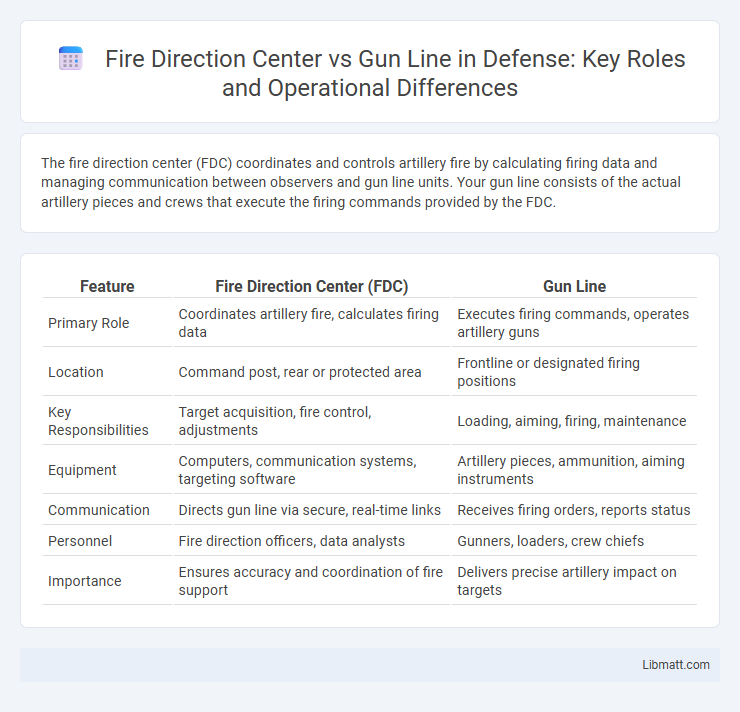The fire direction center (FDC) coordinates and controls artillery fire by calculating firing data and managing communication between observers and gun line units. Your gun line consists of the actual artillery pieces and crews that execute the firing commands provided by the FDC.
Table of Comparison
| Feature | Fire Direction Center (FDC) | Gun Line |
|---|---|---|
| Primary Role | Coordinates artillery fire, calculates firing data | Executes firing commands, operates artillery guns |
| Location | Command post, rear or protected area | Frontline or designated firing positions |
| Key Responsibilities | Target acquisition, fire control, adjustments | Loading, aiming, firing, maintenance |
| Equipment | Computers, communication systems, targeting software | Artillery pieces, ammunition, aiming instruments |
| Communication | Directs gun line via secure, real-time links | Receives firing orders, reports status |
| Personnel | Fire direction officers, data analysts | Gunners, loaders, crew chiefs |
| Importance | Ensures accuracy and coordination of fire support | Delivers precise artillery impact on targets |
Introduction to Fire Direction Center vs Gun Line
The Fire Direction Center (FDC) coordinates and controls artillery fire by calculating targeting data and directing gun line units to achieve precise impacts. Gun lines consist of artillery pieces that physically execute firing orders based on FDC commands. Your mission accuracy depends on seamless communication between the FDC's calculations and the gun line's execution of fire missions.
Roles and Responsibilities of the Fire Direction Center
The Fire Direction Center (FDC) plays a critical role in artillery operations by calculating firing data and coordinating target acquisition for maximum accuracy. It processes mission requests, determines gun elevation and deflection, and communicates precise instructions to the gun line. The FDC ensures synchronization between target information and artillery units, optimizing fire support and battlefield effectiveness.
Functions and Tasks of the Gun Line
The gun line is responsible for executing direct artillery fire missions by operating cannons, howitzers, or rocket launchers to deliver precise and timely fire support on the battlefield. Key tasks include loading ammunition, targeting designated coordinates, maintaining and calibrating weapon systems, and adjusting fire based on spotter feedback. Your ability to respond quickly and accurately within the gun line is critical for suppressing enemy forces and supporting infantry advances.
Communication Flow Between FDC and Gun Line
Effective communication flow between the Fire Direction Center (FDC) and the gun line is critical for precise artillery targeting. The FDC processes targeting data and transmits firing commands via secure radio or digital communication systems to the gun line, ensuring rapid and accurate adjustments. Your ability to maintain clear, uninterrupted communication channels directly impacts artillery effectiveness and mission success.
Key Differences in Operations
The Fire Direction Center (FDC) coordinates and calculates precise artillery fire missions, translating targeting data into firing solutions, while the Gun Line executes actual firing using those instructions. The FDC manages communication, targeting adjustments, and timing, serving as the operational hub for indirect fire support, whereas the Gun Line focuses on loading, aiming, and firing the weapons. Your ability to synchronize both elements is critical for effective and accurate artillery fire on the battlefield.
Coordination and Synchronization in Artillery Units
The fire direction center (FDC) plays a critical role in coordinating and synchronizing artillery units by processing target data, calculating firing solutions, and issuing precise fire commands to the gun line. Effective communication between the FDC and the gun line ensures timely adjustments to range, azimuth, and ammunition type, maximizing accuracy and lethality. This seamless coordination enhances the overall fire mission efficiency, allowing artillery units to deliver synchronized, massed fires that support maneuver forces effectively.
Technological Tools Used by FDC and Gun Line
The Fire Direction Center (FDC) employs advanced digital fire control systems, ballistic computers, and GPS technology to calculate firing data with precision and coordinate artillery strikes effectively. In contrast, the Gun Line relies on automated loading mechanisms, targeting sensors, and communication radios to execute firing commands promptly and maintain synchronization with the FDC. Your understanding of these technological tools enhances coordination and accuracy between the FDC and Gun Line during artillery operations.
Training Requirements and Skill Sets
Fire Direction Center personnel require advanced training in ballistic calculations, target acquisition, and fire coordination to accurately compute firing data and ensure mission success. Gun line crews focus on mastering weapon operation, maintenance, and rapid response skills to execute precise, timely fire upon receiving commands from the FDC. Your readiness depends on understanding the complementary expertise of both units, as effective artillery operations rely on seamless coordination between FDC analysts and gun line operators.
Challenges and Solutions in Fire Mission Execution
Fire Direction Centers (FDCs) face challenges in coordinating accurate and timely fire missions due to complex calculations, communication delays, and dynamic battlefield conditions. Gun lines must address targeting precision and synchronization while adapting to terrain and enemy movement to ensure effective rounds on target. Your success depends on seamless communication between the FDC and gun line, leveraging advanced targeting software and robust protocols to overcome these operational challenges.
Impact on Battlefield Effectiveness
The Fire Direction Center (FDC) coordinates and adjusts artillery fire with precision, significantly enhancing target accuracy and synchronization on the battlefield, which directly improves combat effectiveness. In contrast, the gun line executes the actual firing operations, delivering the physical firepower necessary to neutralize enemy threats and support maneuver units. Efficient communication between the FDC and gun line is critical, as it ensures timely and accurate artillery support, maximizing the overall impact on battlefield outcomes.
fire direction center vs gun line Infographic

 libmatt.com
libmatt.com